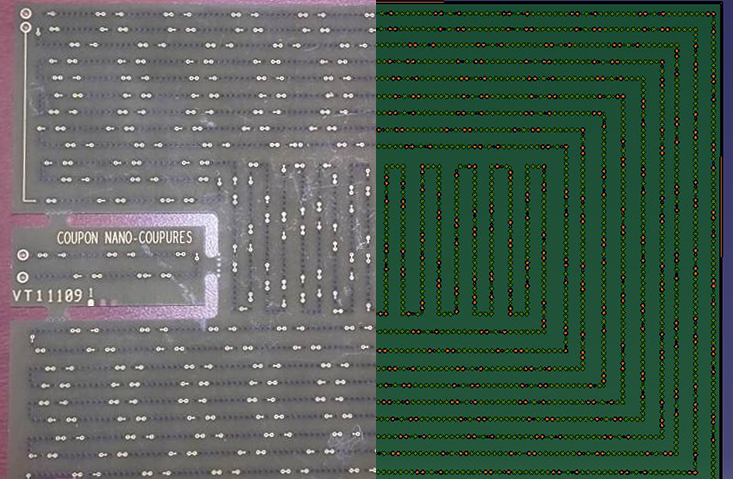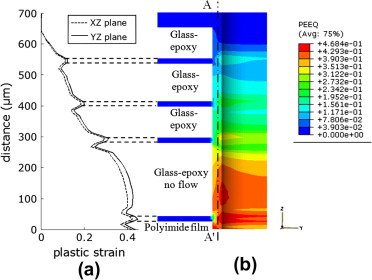Modelling of the thermomechanical behavior of composites
 From tomography to Finite Element calculations to capture the behavior of plain weave materials
From tomography to Finite Element calculations to capture the behavior of plain weave materials
From uniaxial tensile tests, 4 elastic moduli are evaluated. Nevertheless, 5 moduli remain unknown. Owing to the thickness of the thin films, we have developed a numerical strategy to provide estimates for the 5 out of plane elastic moduli.
Microtomography device enables to describe precisely the structure of the yarns. The geometry of the weaving pattern is captured .
To determine the whole anisotropic behavior of the layer, a two step process is adopted. Firstly, based on tomography views, a numerical representation volume element is designed in a finite element software. Secondly, various loading conditions (3 tensile and 3 shear loadings) are prescribed to the remote boundary of the RVE through periodic boundary conditions. From these 6 elementary loading, the 9 moduli are evaluated. A direct comparison of the predictions and of the in-plane moduli, which have been determined by the direct measurement, shows the accuracy of the model. Note that when the behavior of the resin is unknown, an inverse method is performed, the in-plane properties serving as reference for the determination of the matrix properties.
Plasticity of copper
The copper is the essential constituant which ensures the electrical connectivity inside the board. Any defect occurring in any part of copper pathes or vias triggers the breakdown of the board. In addition, during thermal cycles, thermal stresses generate plasticity in copper. As a consequence, the plastic behavior of copper during cyclic loading is enssential. In LEMCI, we have developed specific samples to determine the cyclic behavior of copper. The tests are carried out on the E3000 testing device. Based on the cyclic response, a plasticity model combining cyclic and isotropic hardening has been identified. Note that the model parameters change when rolled annealed or electrodeposited copper are considered. This model based on a Lemaitre and Chaboche model, is implemented on a finite element software.
3D representation of the board
 Left : test vehicles build for a research project where PHT and buried holes are connected via a daisy chain in a flex rigid board. The research program was supported by the DGA/RAPID program (MACIF project). Right : representation in 3D of the same test vehicle via the numerical strategy developed within LEMCI to generate from the GERBER file, a full and accurate representation of the board. Left : test vehicles build for a research project where PHT and buried holes are connected via a daisy chain in a flex rigid board. The research program was supported by the DGA/RAPID program (MACIF project). Right : representation in 3D of the same test vehicle via the numerical strategy developed within LEMCI to generate from the GERBER file, a full and accurate representation of the board. |
In the PCB industry, the manufacturer, usually a SME, receives the design of the board from the end-user. Note that only 2D files (Gerber files) are provided and this 2D representation does not permit to simulate the behavior of the board via numerical software. With LEMCI, we propose to create from the 2D gerber files, an exact representation of the board in 3D, with all details. With the know-how of the LEMCI team, we can extract the specific configuration which are critical and we propose to test the reliability of the board via finite element methods.
|
Numerical simulations of specific configurations
 Heterogenity of the plastic deformation in a buried via.. MACIF research program. (a) Plastic strain in different parts of the copper plating after 50 cycles (b) View of the accumulated plastic strain. It has been shown that the plasticity cumulates closely to no-flow materials Heterogenity of the plastic deformation in a buried via.. MACIF research program. (a) Plastic strain in different parts of the copper plating after 50 cycles (b) View of the accumulated plastic strain. It has been shown that the plasticity cumulates closely to no-flow materials |
LEMCI is able to characterize the material properties of base materials. From measurements, salient models (orthotropic elastic behavior, kinematic hardening for copper, homogenization model for composite materials) are adopted and implemented in finite element calculations. LEMCI benefits from the LEM3 expertise in mechanics of materials. With the 3D representation of the board, together with the precise material description, FE simulation can be as accurate as possible. We can verify the reliability of some critical configurations prior to any test vehicles. As a consequence, the need of a better design can be anticipated. Knowing precisely how plasticity develops in copper, is a key factor to determine the ftigue lifetime of the board.
|
